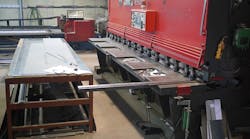The Occupational Safety and Health Review Commission (OSHRC) recently voted unanimously to vacate two machine-guard citations lodged against employers by the Occupational Safety and Health Administration (OSHA) and substantially reduced the penalty imposed in a third case, holding that unsafe employee behavior should have been weighed more heavily.
In a Sept. 21 decision involving the Aerospace Testing Alliance, the commission reversed a decision made by an administrative law judge (ALJ) and vacated a citation lodged against the company under Section 1910.212(a)(1) of OSHA’s machine guarding regulations, which had alleged a failure to guard the hold-down pistons of a power shear.
That section of the rules states, “One or more methods of machine guarding shall be provided to protect the operator and other employees in the machine area from hazards such as those created by point of operation, ingoing nip points, rotating parts, flying chips and sparks. The guard shall be such that it does not offer an accident hazard in itself.”
In this case, the tip of an experienced journeyman sheet metal worker’s finger was crushed while operating a power shear in the metal shop. He had removed a glove and circumvented a guard by placing his finger underneath the guard and piston on tip of the piece of metal he was cutting.. The accident prompted OSHA to conduct an inspection and issue the company a one-item serious citation.
To prove a violation of an OSHA standard, OSHA must prove the cited standard applies, there was a failure to comply with the standard, employees were exposed to the violative condition, and the employer knew or could have known of the violative condition with the exercise of reasonable diligence.
At issue was whether OSHA had established that the existing guard on the power shear’s hold-down pistons was “inadequate to ‘protect’ employees from the crushing hazard.” OSHA argued that machine guarding must physically prevent access to the hazard and that the employer cannot rely on employee behavior.
The commission rejected the argument because the guard was sufficient to prevent inadvertent contact with the pistons. In addition, OSHRC said that because the principle that employers may not rely on correct employee behavior for safety does not apply when an employee deliberately bypasses an otherwise adequate guard, notes Davis Jenkins, an attorney with the law firm of Ogletree Deakins.
The commission concluded that based on how employees operated the machine, it was not “reasonably predictable that employees [would] intentionally place their fingers underneath the guards” and the record did not support a finding that the machine functioned or was operated in a way that would allow an employee’s fingers to inadvertently slip underneath a hold-down piston guard.
Employee Can Be at Fault
“A takeaway from the Aerospace decision is the commission’s observation concerning the overlap between the noncompliance and exposure elements that OSHA must prove to establish a machine guarding violation,” Jenkins explained. “While an employee injury may show exposure to a hazard, it does not necessarily establish that a failure to comply with the machine guarding standard.”
Employers often find themselves facing a seemingly uphill battle when defending against a machine-guarding citation involving a serious injury, Jenkins pointed out.
“While the Aerospace decision is perhaps not a groundbreaking change in the law, the commission emphasized that the occurrence of the injury does not, by itself, establish that the guard was noncompliant with OSHA’s rules,” he said. OSHRC also said a machine guard can “nonetheless be compliant if the operator’s actions [are] not reasonably predictable given the machine’s normal operation.”
In the second case, this time involving Wayne Farms, an employee was injured when he was pulled into a poultry breading machine after he lifted the hopper’s metal gate and reached inside the machine while it was running, explained attorney Melanie L. Paul of the Jackson Lewis law firm.
The commission upheld the ALJ’s decision to vacate the citation on the same grounds as in Aerospace Testing Alliance. OSHRC found that the machine guarding was sufficient in the normal operation of the machine, but the employee bypassing the guard was not reasonably predictable and thus there was no non-compliance condition during the normal operation and normal job tasks related to that machine.
In the third case, OSHA cited Dover High-Performance Plastic with a willful machine guarding violation for allowing employees to operate lathes and mills with the doors either opened or removed. The commission upheld the citation in regard to the lathes and not the mills, and it reclassified the violation from willful to serious.
OSHRC found that the company demonstrated good faith by reprogramming the lathes following a 2012 accident which eliminated the most obvious aspect of the hazard – that an employee could be injured by the component of the lathe that begins to move when the production cycle automatically commences. Because the commission found there had been no violation with respect to the mill equipment and found good faith with respect to the lathes, it reduced the original penalty from $49,000 to $3,500.
“As is often the case, particularly when workplace accidents occur, OSHA will issue citations to employers for alleged safety and health violations,” Paul said. “But, as demonstrated by these three recent decisions, sometimes an accident really is just that and an employer is otherwise meeting its legal obligations.”

